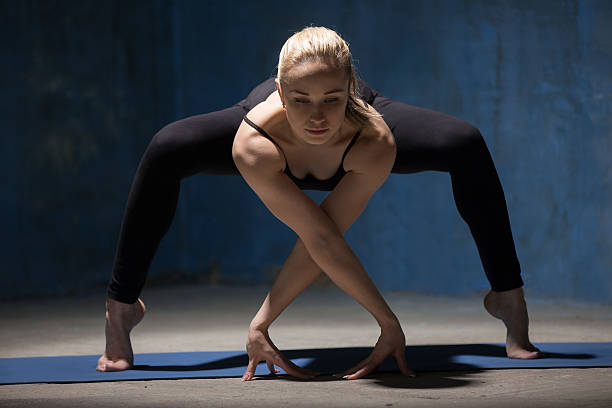The sumo squat is quite similar to a traditional squat, but with a key difference in stance. Here’s how to do it correctly:
- Stand with feet wider than shoulder-width apart. Toes should be facing out at a 45-degree angle.
- Clasp your hands in front of your chest.
- Inhale and sit back into your hips, bending your knees to lower your body until your thighs are parallel to the floor. Don’t round your back.
- Exhale and press through your feet to straighten your legs and return to a standing position.
Remember, maintaining a wide stance and turned-out toes is crucial for proper execution. This positioning ensures the engagement of the targeted muscles and provides stability during the exercise.
Benefits of Sumo Squats
The sumo squat may appear simple, but it offers a range of benefits for your lower-body strength and joints.
Strengthens Inner Thighs – The wide stance targets the inner thigh muscles (hip adductors) which play a vital role in lower-body stability. By strengthening them, you can prevent lower back pain and make your legs stronger overall. Unlike isolation exercises that target a single muscle group, sumo squats are compound movements that engage multiple muscle groups simultaneously, including the glutes, hamstrings, and quads.
Relieves Hip Flexor Tightness – If you spend long hours sitting at a desk, you likely experience tight hip flexors, which can lead to strain on other muscles, such as the lower back. Sumo squats can help alleviate this tightness by opening up the hips.
Puts Less Pressure on Knees – Compared to traditional squats, sumo squats exert less stress on the knee joint. By engaging various muscle groups, particularly the inner thighs, sumo squats distribute the workload and reduce pressure on the knees. This makes them a suitable option for individuals with knee pain or discomfort.
Muscles Targeted by Sumo Squats
In addition to the hip adductors and hip flexors, sumo squats also engage other muscles in your lower body, including:
- Glutes. Sumo squats target the gluteus medius and gluteus minimus, which are responsible for leg abduction and inward rotation. These muscles support hip stability and contribute to a well-rounded lower-body workout.
- Calves. The flared-out position of your toes when doing this exercise places additional emphasis on your calf muscles compared to a traditional squat. As a result, you get to do a bit more calf work, adding to the overall lower-body strengthening benefits.
- Quads and Hamstrings. Just like in traditional squats, sumo squats also engage the quadriceps (front of the thighs) and hamstrings (back of the thighs) which play a crucial role in lower-body strength and power.
- Core. Sumo squats challenge your core muscles as they help stabilize your body throughout the movement. Maintaining proper form and a stable torso is essential for maximizing the benefits of the exercise.
Common Mistakes to Avoid
To ensure you’re getting the most out of your exercise and reducing the risk of injury, be mindful of these common mistakes:
Knee Alignment – Keep your knees aligned with your toes throughout the movement. Avoid allowing your knees to cave inward, as this can strain the joint and lead to discomfort or injury.
Lower Back Rounding – Maintain a neutral spine and avoid rounding your lower back. Rounding may indicate tight hip flexors or a lack of core strength.
Next time you workout at Blast Fitness, try to incorporate some sumo squats.
Learn how to do the sumo squat here:
